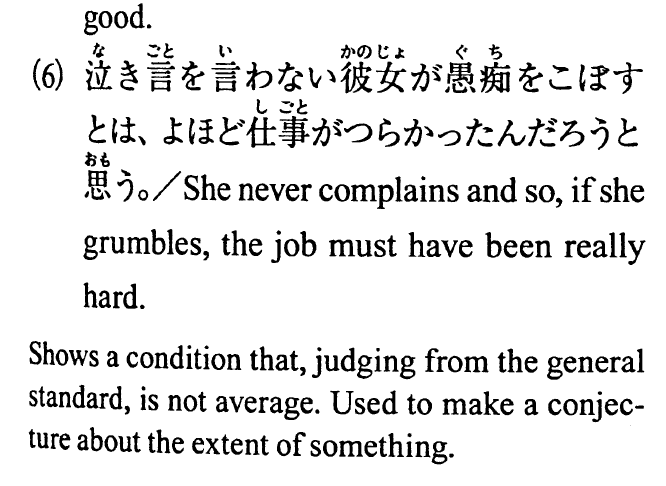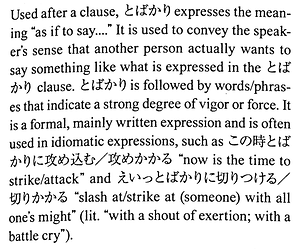Not sure if it’s been mentioned yet, but I came across ゆえ in a few articles recently.
(From Stack Exchange)
So, how do you translate 「行くとする」? Pretty much anything that reflects your understanding of the nuance “proceeding to perform a new action (by quitting what one is currently doing)” would do.
“I think we should get going.”, “We really hafta get going.”, etc., perhaps?
Although we could possibly do another grammar point for this, I would just like to point out that is has to do with the control factor that I mentioned in a post recently. The English translations presented there also have the feeling of ‘to try to start something new, but not have full control’, that’s why it comes off as
“I think we should get going (but maybe something is stopping us).”
“We really hafta get going (is it ok if we leave?).”, etc., perhaps?
It’s not just ‘quitting what you’re doing’, it’s usually looking for some kind of approval from someone, or hinting at that it is not easy to start the new thing due to some feeling/hindrance.
One year after this comment this N2 grammar point or AIAJ chapter 13 path is still missing…
The usage is not simple as in the quote above…

After watching this video on だけ (verb + だけ + same verb), I tried to see if this grammar was on here, and the closest I found was だけは, which seems different than what was described in this video.
Mentioning it here jic.
AとはいいながらB would be a good one to add for N2.
An awesome grammar point for the planned JLPT0 grammar group.
っこ - doing together; doing to each other; contest; match
(There is っこない | Japanese Grammar SRS, but it seems to me it’s insufficient to cover the topic.)
Maybe split 〜に対して and 〜のに対して into separate grammar points?
In the JLPT N5 on Dec 5th 2021 I encountered at least 2 points that were not allocated to Bunpro N5 grammar:
いかが (seems to be missing entirely)
ながら (part of N4)
Hi Das!
I am sorry to hear that the N5 included some of the grammar that was allocated differently on here. I am actually quite surprised to hear that ながら was in N5 though, that is fairly advanced for that level 
There will always be a few questions that fall either outside of their level, or perhaps are newly added to a level on a specific test or a specific year. いかが is the polite equivalent of どう (which you probably know now). We do not have it mainly because we do not actually have a dedicated lesson for どう itself at this stage. Once we separate どう into it’s own grammar point, we will likely include いかが as part of the description on there.
The “problem” with JLPTs that always I’ve been told is that there’s not a closed Kanji or Grammar list, and some of them might be in the gray zone between levels.
It’s been a while since I have taken one of the tests, not sure if that has changed.
There are many gray zone grammar points for every level unfortunately. All we can do is go based off of frequency of what appears where most often.
found another missing point: ほど in its “to the degree of” meaning. I like this one a lot because it lets me make metaphorical comparisons, and it doesn’t have the zillions of meanings the way よう does to confuse the listener.
I tried to use it in this sentence during my reviews: 10代に戻った___楽しかった。
(though after checking my textbook I’m don’t think ほど is grammatically correct here since it doesn’t list it being usable after past tense)
some sample sentences from Try! N3:
- あの双子は両親も見違えるほどよく似ている。
- 今週やらなければならない仕事が山ほどある。
〜のだから
For example:
- Shin Kanzen Master N3 p. 31
- grammar - のだから vs のだ (んだから vs んだ) - Japanese Language Stack Exchange
We have ほど here  . This meaning covers extent, and a few other things. In the example sentence you sent, while ほど would be grammatically correct, it would be a little bit unnatural. This is because ほど measures ‘real’ extents. Which would mean that the person who is speaking in that sentence literally became a teenager again.
. This meaning covers extent, and a few other things. In the example sentence you sent, while ほど would be grammatically correct, it would be a little bit unnatural. This is because ほど measures ‘real’ extents. Which would mean that the person who is speaking in that sentence literally became a teenager again.
If you wanted to use ほど in a sentence like that, you’d need to put it after a ‘feeling’, as a feeling can be measured. For example:
10代に戻ったと感じたほど楽しかった。
I had fun to the extent that I felt that I had returned to my teens.
In this way, because the feeling itself is being measured, ほど will work well.
Perhaps it was not available before, but is it this grammar point?
Came here to ask if bunpro has the imperative form as a grammar point? I searched for it and was really surprised when nothing came up; I even checked my spelling.
Am I just missing it or does it not exist as a grammar point?
You are correct (unfortunately)… They have the opposite though (neg. imperative)…
な | Japanese Grammar SRS
Was totally dumbfounded to find that there was no grammar point for ~てたまる(もの)か, despite being quite certain that I had learned it on here 
https://www.imabi.net/tetamaru.htm
We do have ~てたまらない but the meaning is rather different of course.


